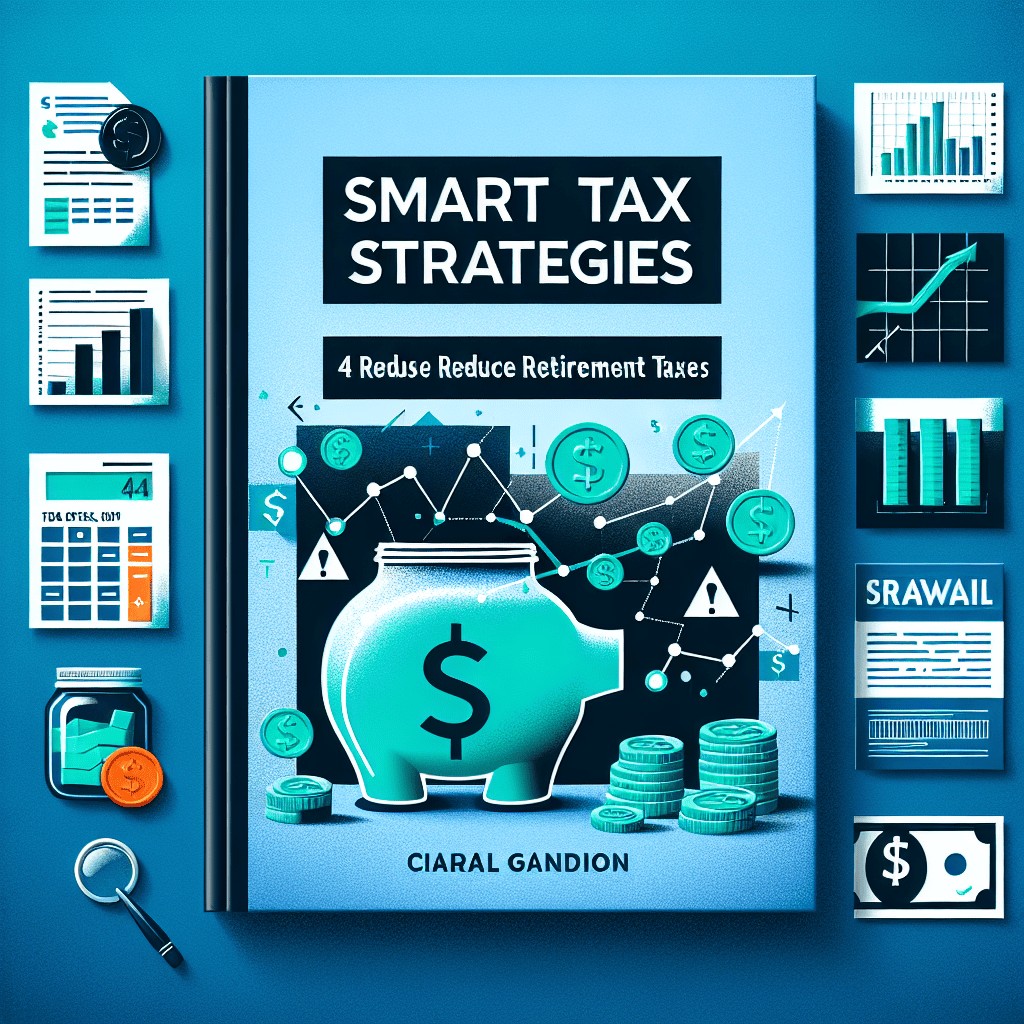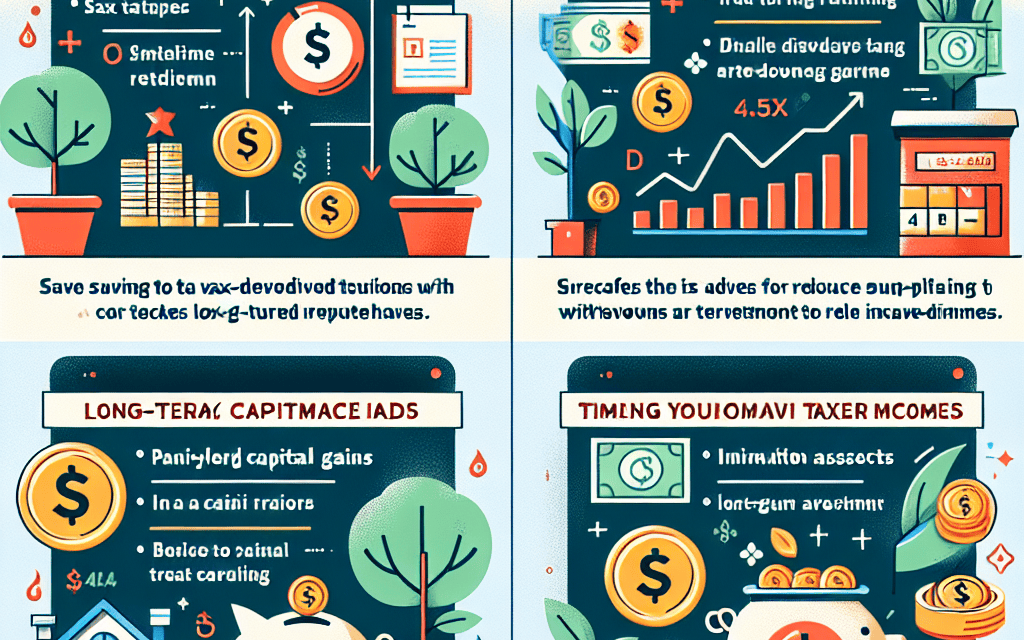“Maximize Your Nest Egg: Smart Tax Strategies for a Tax-Efficient Retirement”
Introduction
Retirement planning involves more than just saving money; it also requires strategic tax planning to maximize your income and preserve your wealth. As you transition into retirement, understanding how taxes can impact your savings is crucial. Smart tax strategies can help you minimize your tax burden, allowing you to keep more of your hard-earned money. This guide explores four effective ways to reduce retirement taxes, including managing capital gains. By implementing these strategies, you can optimize your retirement income, ensuring a more financially secure and comfortable future.
Understanding Tax-Deferred Accounts: Maximize Your Retirement Savings
Understanding tax-deferred accounts is crucial for maximizing your retirement savings and effectively managing your tax liabilities. As you plan for retirement, it is essential to consider strategies that can help reduce the taxes you will owe, including those on capital gains. By employing smart tax strategies, you can ensure that more of your hard-earned money remains in your pocket, allowing you to enjoy a more comfortable retirement.
One of the most effective ways to reduce retirement taxes is by utilizing tax-deferred accounts such as traditional IRAs and 401(k) plans. These accounts allow you to contribute pre-tax dollars, which can significantly lower your taxable income during your working years. The funds in these accounts grow tax-deferred, meaning you do not pay taxes on the earnings until you withdraw them in retirement. This can be particularly advantageous if you expect to be in a lower tax bracket during retirement, as you will pay less in taxes on the withdrawals.
In addition to traditional IRAs and 401(k) plans, Roth IRAs offer another valuable tax strategy. While contributions to Roth IRAs are made with after-tax dollars, the withdrawals in retirement are tax-free, provided certain conditions are met. This can be especially beneficial if you anticipate being in a higher tax bracket in the future. By strategically allocating your retirement savings between traditional and Roth accounts, you can create a tax-diversified portfolio that provides flexibility in managing your tax liabilities during retirement.
Another important consideration is the timing of your withdrawals. By carefully planning when to take distributions from your retirement accounts, you can minimize the impact on your tax bracket. For instance, if you have both taxable and tax-deferred accounts, you might choose to withdraw from the taxable accounts first, allowing the tax-deferred accounts to continue growing. This strategy can help you manage your taxable income and potentially reduce the amount of taxes owed on capital gains.
Moreover, it is essential to be mindful of the required minimum distributions (RMDs) from tax-deferred accounts, which typically begin at age 72. Failing to take RMDs can result in significant penalties, so it is crucial to incorporate these into your tax planning strategy. By understanding the rules surrounding RMDs and planning accordingly, you can avoid unnecessary tax burdens and ensure compliance with IRS regulations.
Additionally, capital gains taxes can have a substantial impact on your retirement savings. To mitigate this, consider strategies such as tax-loss harvesting, which involves selling investments that have lost value to offset gains from other investments. This can help reduce your overall capital gains tax liability. Furthermore, holding investments for more than a year can qualify them for long-term capital gains tax rates, which are generally lower than short-term rates. By strategically managing your investment portfolio, you can optimize your tax situation and preserve more of your retirement savings.
In conclusion, understanding and implementing smart tax strategies is essential for maximizing your retirement savings and minimizing your tax liabilities. By utilizing tax-deferred accounts, considering Roth IRAs, planning the timing of withdrawals, and managing capital gains, you can create a comprehensive retirement plan that aligns with your financial goals. As you navigate the complexities of retirement planning, it is advisable to consult with a financial advisor or tax professional to ensure that your strategies are tailored to your unique circumstances and comply with current tax laws.
Roth IRA Conversions: A Strategic Approach to Minimize Future Taxes
As individuals approach retirement, the prospect of managing taxes becomes a crucial aspect of financial planning. One strategic approach to minimizing future taxes is through Roth IRA conversions. This method not only offers the potential for tax-free growth but also provides a way to manage taxable income in retirement effectively. By understanding the nuances of Roth IRA conversions, retirees can make informed decisions that align with their long-term financial goals.
To begin with, a Roth IRA conversion involves transferring funds from a traditional IRA or 401(k) into a Roth IRA. The primary advantage of this conversion is that, while the transferred amount is subject to income tax in the year of conversion, future withdrawals from the Roth IRA are tax-free, provided certain conditions are met. This can be particularly beneficial for retirees who anticipate being in a higher tax bracket in the future or who wish to avoid required minimum distributions (RMDs) that apply to traditional IRAs.
Moreover, timing plays a critical role in maximizing the benefits of a Roth IRA conversion. Converting during years of lower income can minimize the tax impact, as the conversion amount is added to taxable income for that year. For instance, early retirement years, when individuals may not yet be receiving Social Security benefits or drawing from other retirement accounts, can present an opportune time for conversion. Additionally, spreading conversions over several years can help manage tax liabilities and prevent pushing oneself into a higher tax bracket.
In addition to timing, another consideration is the impact of Roth IRA conversions on capital gains taxes. By strategically managing taxable income through conversions, retirees can potentially reduce the tax rate applied to capital gains. For example, keeping taxable income below certain thresholds can ensure that long-term capital gains are taxed at a lower rate or even at zero percent. This interplay between Roth conversions and capital gains tax rates underscores the importance of comprehensive tax planning.
Furthermore, Roth IRA conversions can serve as an effective estate planning tool. Since Roth IRAs do not require RMDs during the account holder’s lifetime, they can continue to grow tax-free, potentially leaving a larger inheritance for beneficiaries. Additionally, beneficiaries of Roth IRAs can enjoy tax-free withdrawals, which can be a significant advantage compared to inheriting traditional IRAs that are subject to income tax upon distribution.
However, it is essential to approach Roth IRA conversions with careful consideration and professional guidance. The decision to convert should be based on a thorough analysis of one’s current and projected financial situation, including tax implications, cash flow needs, and long-term retirement goals. Consulting with a financial advisor or tax professional can provide valuable insights and help tailor a conversion strategy that aligns with individual circumstances.
In conclusion, Roth IRA conversions offer a strategic avenue for minimizing future taxes in retirement. By understanding the benefits and intricacies of this approach, retirees can make informed decisions that enhance their financial security. Whether it is through timing conversions to coincide with lower income years, managing capital gains tax rates, or leveraging the estate planning advantages, Roth IRA conversions can play a pivotal role in a comprehensive retirement tax strategy. As with any financial decision, careful planning and professional advice are key to optimizing outcomes and achieving a secure and tax-efficient retirement.
Capital Gains Tax Management: Timing and Strategies for Retirees
As retirees transition into a new phase of life, managing taxes becomes a crucial aspect of financial planning. One of the most significant tax considerations for retirees is the capital gains tax, which can substantially impact the overall financial health of an individual. Understanding how to effectively manage capital gains taxes can lead to significant savings and a more secure retirement. By employing strategic timing and other tax-efficient strategies, retirees can minimize their tax liabilities and maximize their retirement income.
To begin with, timing plays a pivotal role in managing capital gains taxes. Retirees should consider the timing of asset sales to take advantage of lower tax rates. For instance, holding onto investments for more than a year qualifies them for long-term capital gains tax rates, which are generally lower than short-term rates. This simple yet effective strategy can result in considerable tax savings. Additionally, retirees should be mindful of their income levels, as capital gains can push them into higher tax brackets. By strategically timing the sale of assets, retirees can manage their taxable income and potentially remain in a lower tax bracket.
Moreover, tax-loss harvesting is another valuable strategy for retirees looking to manage capital gains taxes. This involves selling investments that have experienced a loss to offset gains from other investments. By doing so, retirees can reduce their overall taxable income. It is important to note that the IRS allows individuals to offset up to $3,000 of ordinary income with capital losses each year, with any remaining losses carried forward to future years. This strategy not only helps in managing taxes but also provides an opportunity to rebalance investment portfolios in line with retirement goals.
In addition to timing and tax-loss harvesting, retirees should consider the benefits of tax-advantaged accounts. Utilizing accounts such as Roth IRAs or Health Savings Accounts (HSAs) can provide significant tax advantages. For instance, qualified withdrawals from a Roth IRA are tax-free, which can be particularly beneficial for managing capital gains taxes. By strategically withdrawing from these accounts, retirees can minimize their taxable income and potentially reduce their capital gains tax liability. Furthermore, HSAs offer a triple tax advantage: contributions are tax-deductible, growth is tax-free, and withdrawals for qualified medical expenses are also tax-free. This makes HSAs an excellent tool for managing healthcare costs in retirement while also providing tax benefits.
Lastly, gifting appreciated assets to family members or charitable organizations can be an effective way to manage capital gains taxes. By gifting assets, retirees can remove the asset from their taxable estate and potentially reduce their capital gains tax liability. When gifting to family members, it is important to consider their tax situation, as they will assume the original cost basis of the asset. On the other hand, donating appreciated assets to a qualified charity allows retirees to avoid capital gains taxes altogether while also receiving a charitable deduction.
In conclusion, managing capital gains taxes is an essential component of retirement planning. By employing strategies such as timing asset sales, tax-loss harvesting, utilizing tax-advantaged accounts, and gifting appreciated assets, retirees can effectively reduce their tax liabilities. These strategies not only provide immediate tax benefits but also contribute to a more secure and financially stable retirement. As with any financial planning strategy, it is advisable for retirees to consult with a tax professional to tailor these strategies to their individual circumstances and ensure compliance with current tax laws.
Utilizing Tax Credits and Deductions: Enhance Your Retirement Income

As individuals approach retirement, the focus often shifts from accumulating wealth to preserving it. One of the most effective ways to enhance retirement income is by strategically utilizing tax credits and deductions. By doing so, retirees can significantly reduce their tax liabilities, including those associated with capital gains. Understanding and implementing smart tax strategies can make a substantial difference in the financial well-being of retirees, allowing them to enjoy their golden years with greater peace of mind.
To begin with, it is essential to recognize the importance of tax-efficient withdrawals from retirement accounts. Traditional IRAs and 401(k)s are subject to ordinary income tax upon withdrawal, which can significantly impact the net income available during retirement. By carefully planning the timing and amount of these withdrawals, retirees can minimize their tax burden. For instance, spreading out withdrawals over several years can prevent retirees from being pushed into higher tax brackets, thereby reducing the overall tax rate applied to their income.
In addition to managing withdrawals, retirees should consider the benefits of Roth conversions. Converting a traditional IRA to a Roth IRA involves paying taxes on the converted amount in the year of conversion. However, once the funds are in a Roth IRA, they grow tax-free, and qualified withdrawals are also tax-free. This strategy can be particularly advantageous for those who anticipate being in a higher tax bracket in the future or who wish to leave a tax-free inheritance to their heirs. By strategically converting portions of their traditional IRA to a Roth IRA during low-income years, retirees can effectively manage their tax liabilities over time.
Moreover, retirees should not overlook the potential of capital gains tax management. Capital gains taxes apply to the profit made from selling investments such as stocks, bonds, or real estate. By holding investments for more than a year, retirees can benefit from the lower long-term capital gains tax rates. Additionally, strategically selling investments in years when their taxable income is lower can further reduce the capital gains tax burden. For those in the lowest tax brackets, it is even possible to pay zero percent on long-term capital gains, making this a crucial consideration for tax planning.
Furthermore, retirees can enhance their retirement income by taking advantage of available tax credits and deductions. The Saver’s Credit, for example, rewards low- to moderate-income individuals who contribute to retirement accounts. Although this credit is often associated with those still in the workforce, retirees who continue to contribute to retirement accounts can also benefit. Additionally, deductions for medical expenses, charitable contributions, and mortgage interest can significantly reduce taxable income, thereby lowering the overall tax liability.
In conclusion, by employing smart tax strategies, retirees can effectively reduce their tax liabilities and enhance their retirement income. Through careful management of retirement account withdrawals, strategic Roth conversions, capital gains tax planning, and the utilization of tax credits and deductions, retirees can preserve more of their hard-earned wealth. As tax laws and personal financial situations can be complex, consulting with a financial advisor or tax professional is advisable to tailor these strategies to individual circumstances. Ultimately, a well-planned approach to taxes can provide retirees with greater financial security and peace of mind as they enjoy their retirement years.
Charitable Giving: Tax-Efficient Strategies for Retirees
As retirees navigate the complexities of managing their finances, one area that often requires careful consideration is tax efficiency, particularly when it comes to charitable giving. Charitable contributions not only provide an opportunity to support meaningful causes but also offer potential tax benefits that can significantly impact one’s financial landscape. By employing smart tax strategies, retirees can effectively reduce their tax liabilities, including those associated with capital gains, while maximizing the impact of their philanthropic efforts.
To begin with, one of the most effective strategies for tax-efficient charitable giving is the use of Qualified Charitable Distributions (QCDs). Retirees aged 70½ or older can directly transfer up to $100,000 annually from their Individual Retirement Accounts (IRAs) to a qualified charity. This approach not only satisfies the required minimum distribution (RMD) but also excludes the transferred amount from taxable income. Consequently, QCDs can be a powerful tool for reducing taxable income, thereby lowering the overall tax burden. Moreover, this strategy can be particularly advantageous for those who do not itemize deductions, as it allows them to benefit from a tax-efficient donation without needing to exceed the standard deduction threshold.
In addition to QCDs, retirees can also consider donating appreciated securities, such as stocks or mutual funds, directly to charitable organizations. By doing so, they can avoid paying capital gains taxes on the appreciation of these assets. This method not only provides a larger donation to the charity, as the full market value of the securities is transferred, but also allows the donor to claim a charitable deduction for the full market value if they itemize deductions. This dual benefit of bypassing capital gains taxes and receiving a deduction can significantly enhance the tax efficiency of charitable giving.
Another strategy to consider is the establishment of a Donor-Advised Fund (DAF). A DAF allows retirees to make a charitable contribution, receive an immediate tax deduction, and then recommend grants from the fund to their chosen charities over time. This approach offers flexibility in both timing and distribution, enabling retirees to strategically plan their charitable giving in alignment with their tax situation. Additionally, contributions to a DAF can include cash, appreciated securities, or other assets, providing a versatile option for managing charitable donations.
Furthermore, retirees may explore the option of creating a Charitable Remainder Trust (CRT). A CRT allows individuals to transfer assets into a trust, which then provides income to the donor or other beneficiaries for a specified period. At the end of this period, the remaining assets are donated to a designated charity. This strategy not only offers an immediate charitable deduction but also defers capital gains taxes on the sale of appreciated assets within the trust. By utilizing a CRT, retirees can achieve a balance between securing income and fulfilling their philanthropic goals.
In conclusion, retirees have several avenues to explore when it comes to tax-efficient charitable giving. By leveraging strategies such as Qualified Charitable Distributions, donating appreciated securities, establishing Donor-Advised Funds, and creating Charitable Remainder Trusts, they can effectively reduce their tax liabilities while supporting causes they care about. These approaches not only enhance the impact of their donations but also contribute to a more financially secure retirement. As always, it is advisable for retirees to consult with financial advisors or tax professionals to tailor these strategies to their individual circumstances and ensure compliance with current tax laws.
State Tax Considerations: Choosing a Tax-Friendly Retirement Location
When planning for retirement, one of the most crucial considerations is the impact of state taxes on your financial well-being. Choosing a tax-friendly retirement location can significantly influence your overall tax burden, including income taxes, property taxes, and capital gains taxes. As retirees often rely on fixed incomes, understanding the nuances of state tax policies can help preserve your nest egg and enhance your financial security.
To begin with, it is essential to recognize that state income taxes can vary widely across the United States. Some states, such as Florida, Texas, and Nevada, do not impose a state income tax, making them attractive options for retirees seeking to minimize their tax liabilities. By relocating to a state without income tax, retirees can potentially save thousands of dollars annually, which can be redirected towards other retirement expenses or investments. However, it is important to consider other factors, such as the cost of living and healthcare availability, when evaluating these states.
In addition to income taxes, property taxes can also have a significant impact on retirees’ finances. States like New Jersey and Illinois are known for their high property tax rates, which can erode retirement savings over time. Conversely, states such as Hawaii and Alabama offer relatively low property tax rates, providing a more favorable environment for retirees who own their homes. Moreover, some states offer property tax exemptions or reductions for seniors, which can further alleviate the financial burden. Therefore, it is advisable to research and compare property tax policies when considering a retirement location.
Another critical aspect to consider is the taxation of retirement income, including Social Security benefits, pensions, and withdrawals from retirement accounts. While the federal government taxes Social Security benefits based on income thresholds, some states, like Colorado and Connecticut, offer partial exemptions or credits for these benefits. Additionally, states such as Pennsylvania and Mississippi do not tax retirement income at all, providing a significant advantage for retirees. Understanding how different states tax retirement income can help you make informed decisions about where to settle down.
Furthermore, capital gains taxes can also affect retirees, particularly those who plan to sell investments or real estate during retirement. While federal capital gains tax rates are consistent across the country, state-level taxes can vary. For instance, California imposes a high state capital gains tax, which can significantly impact the proceeds from the sale of assets. In contrast, states without income tax generally do not levy capital gains taxes, offering a more favorable environment for retirees looking to maximize their investment returns. Therefore, evaluating state capital gains tax policies is crucial for retirees with substantial investment portfolios.
In conclusion, selecting a tax-friendly retirement location requires careful consideration of various state tax policies, including income taxes, property taxes, and capital gains taxes. By understanding the tax implications of different states, retirees can make informed decisions that align with their financial goals and lifestyle preferences. While tax considerations are important, it is equally vital to weigh other factors such as climate, healthcare, and community amenities when choosing a retirement destination. Ultimately, a well-researched decision can lead to a more financially secure and fulfilling retirement.
Estate Planning: Reducing Tax Burden for Your Heirs
As individuals approach retirement, the focus often shifts from accumulating wealth to preserving it, ensuring that one’s financial legacy is passed on to heirs with minimal tax implications. Estate planning becomes a crucial component of this process, particularly when considering the potential tax burdens that can diminish the value of an inheritance. Implementing smart tax strategies can significantly reduce retirement taxes, including capital gains, thereby maximizing the benefits for your heirs.
One effective strategy is to take advantage of tax-deferred accounts, such as traditional IRAs and 401(k)s. These accounts allow investments to grow tax-free until withdrawals are made, typically during retirement when individuals may be in a lower tax bracket. By strategically timing withdrawals, retirees can minimize their taxable income, thereby reducing the overall tax burden. Moreover, converting a portion of these accounts to Roth IRAs can be beneficial. Although taxes are paid on the converted amount, future withdrawals from Roth IRAs are tax-free, providing a tax-efficient way to pass on wealth to heirs.
In addition to managing retirement accounts, it is essential to consider the implications of capital gains taxes on investments. One way to mitigate these taxes is through tax-loss harvesting, a strategy that involves selling investments at a loss to offset gains elsewhere in the portfolio. This approach not only reduces the taxable capital gains but also allows investors to rebalance their portfolios in a tax-efficient manner. Furthermore, by holding investments for more than a year, individuals can benefit from the lower long-term capital gains tax rates, which are generally more favorable than short-term rates.
Another strategy to consider is gifting assets during one’s lifetime. The Internal Revenue Service (IRS) allows individuals to gift a certain amount each year without incurring gift taxes. By systematically gifting assets to heirs, retirees can reduce the size of their taxable estate, thereby minimizing estate taxes upon their passing. Additionally, gifting appreciated assets can be particularly advantageous, as the recipient assumes the original cost basis, potentially resulting in lower capital gains taxes when the asset is eventually sold.
Finally, establishing a trust can be an effective way to manage and distribute assets while minimizing tax liabilities. Trusts offer a range of benefits, including control over how and when assets are distributed to beneficiaries. Certain types of trusts, such as irrevocable life insurance trusts, can remove life insurance proceeds from the taxable estate, providing heirs with tax-free funds. Additionally, charitable remainder trusts allow individuals to donate assets to a charity while retaining an income stream during their lifetime. This not only provides a charitable deduction but also removes the asset from the taxable estate, reducing potential estate taxes.
In conclusion, reducing the tax burden for your heirs requires careful planning and a strategic approach to managing retirement accounts, investments, and estate assets. By utilizing tax-deferred accounts, engaging in tax-loss harvesting, gifting assets, and establishing trusts, retirees can effectively minimize taxes, including capital gains, thereby preserving more of their wealth for future generations. As tax laws and regulations can be complex and subject to change, consulting with a financial advisor or estate planning attorney is advisable to tailor these strategies to individual circumstances and ensure compliance with current tax codes.
Q&A
1. **What is tax-efficient withdrawal sequencing?**
Tax-efficient withdrawal sequencing involves strategically withdrawing funds from different retirement accounts in a way that minimizes tax liability. Typically, this means withdrawing from taxable accounts first, then tax-deferred accounts, and finally tax-free accounts like Roth IRAs.
2. **How can Roth conversions help reduce retirement taxes?**
Roth conversions involve transferring funds from a traditional IRA or 401(k) to a Roth IRA. While taxes are paid on the converted amount, future withdrawals from the Roth IRA are tax-free, potentially reducing taxes in retirement.
3. **What role do capital gains play in retirement tax strategies?**
Managing capital gains is crucial for minimizing taxes in retirement. By strategically selling investments, retirees can take advantage of lower long-term capital gains tax rates and offset gains with losses to reduce taxable income.
4. **How can tax-loss harvesting benefit retirees?**
Tax-loss harvesting involves selling investments at a loss to offset capital gains and reduce taxable income. This strategy can help retirees lower their tax bill and potentially improve their overall investment returns.
5. **What is the benefit of using tax-advantaged accounts for retirement savings?**
Tax-advantaged accounts, such as IRAs and 401(k)s, offer tax benefits like deferred taxes on earnings or tax-free withdrawals, which can help reduce overall tax liability in retirement.
6. **How can charitable contributions impact retirement taxes?**
Making charitable contributions directly from an IRA, known as a Qualified Charitable Distribution (QCD), can satisfy required minimum distributions (RMDs) without increasing taxable income, thus reducing taxes.
7. **What is the impact of required minimum distributions (RMDs) on retirement taxes?**
RMDs are mandatory withdrawals from tax-deferred retirement accounts starting at age 72. These distributions are taxed as ordinary income, potentially increasing a retiree’s tax liability, so planning for them is essential to manage taxes effectively.
Conclusion
Smart tax strategies are essential for minimizing retirement taxes and preserving wealth. By utilizing tax-advantaged accounts, such as Roth IRAs and 401(k)s, retirees can benefit from tax-free withdrawals. Strategic asset location, which involves placing income-generating investments in tax-deferred accounts and growth-oriented investments in taxable accounts, can optimize tax efficiency. Additionally, managing capital gains through tax-loss harvesting and long-term investment holding can significantly reduce tax liabilities. Lastly, considering the timing of withdrawals and Social Security benefits can further enhance tax savings. Implementing these strategies can lead to a more financially secure and tax-efficient retirement.





